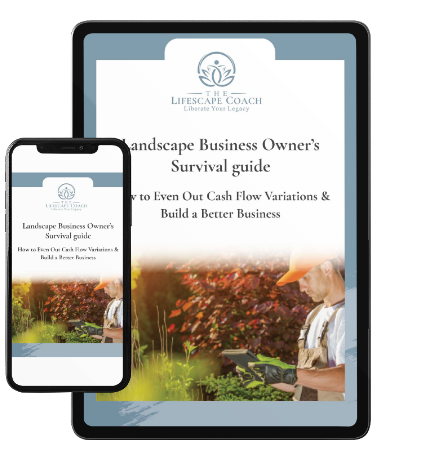How to Avoid These 5 Ginormous Landscape Leadership Mistakes
As an owner, fessing up to missteps in business building and management is hard. When you know something isn’t going well in your operational systems or with your personnel, it’s easy to stand back and put your head in the sand or focus on something less challenging. The cost is your relational and professional credibility with your staff. You can’t afford that cost. It’s both too high and hard to come back from. So, what do you do? You have to face it head-on. Name it clearly without blaming or shaming anyone - especially yourself. Then, outline what needs to be done, write out the steps, and take action.
Here are the 5 ginormous landscape leadership mistakes and how to avoid them
1) The first mistake that landscape business owners make when they know that something isn't going well in their business is to drive harder into something else. This is a tactic used by many professionals and many industries - move the light off of what's not right and shine it on something else.
Problem is, this doesn’t work. It may take the pressure off in the moment, but eventually (and usually sooner rather than later) that spotlight goes right back to the problem.
The solution to this is to face it head on by actually NAMING the issue. This is sometimes best done alone with a pen and paper. It's a safe way to move it from your worry center to your solution center. When we chew on a problem inside our heads, it is tough to grasp the size and shape of it fully. AND, it's very easy for this inaction to spark fear and worry because you are basically in the dark. Putting it on paper is step one to getting a little light and perspective on the problem.
2) The second mistake that landscape business owners make is to notice the problem and then keep it to themselves. If you've taken action to write out the issue and get it out of your head, that's a great start. If you just leave in on the paper - maybe revisiting it a few times, you will definitely be better off than if you left it in your head.
The danger is, you may stay stuck in inaction, and the problem will continue to fester. The solution to avoiding the fester is to get some outside perspective. Trust me, personal perspective is always skewed as "self-referenced," meaning we are at the center of that perspective. What would be best and really helpful is to share that written problem with a trusted manager or accountability partner in your company, an outsourced business partner like a trusted vendor or business colleague or even your attorney, accountant or financial planner.
The point is to share this problem with someone who's invested in your success. It's probably not a great idea to just share this with a spouse or best buddy unless they are connected to your business. I only say this because this can turn the discussion emotional when what you want is pragmatic feedback and some non-judgmental perspective. And remember, the judgment and emotion spark I'm talking about here usually comes from you. My husband is an amazing business support to me on many levels, but when something has really got me spun out into a hot mess, he’s not my go to. I’m too easily triggered. So, I start with my Corporate Affairs Manager, my Marketing Program Manager, and then I leap to my Business Accountability Partner. The three of them have my permission to tell it like it is and give me their clear feedback. They know that I'll need to both vent and process and they provide me with space for that. Only then is it safe for me to draw my husband in. I feel more solid in my own thinking at that point and can receive his valuable perspective and feedback calmly without being triggered.

3) The third mistake that landscape business owners make is that they may vent about their problem - to anyone who will listen - they may even build out a solution to that problem, but they somehow never take action. Or the step they take is peripheral and not head on. What I mean by that is rather than taking the bull by the horns, they dance around it. This isn’t for lack of wanting to solve it, it’s from fear and overwhelm.
Solutions are often scary and big and seem impossible. The answer to this is simple, and it starts with breaking the solution down into bite-size steps. When you do that, you can begin to see what to do first, second and third. If you really want to supercharge your solution, work it with just a few trusted people in your company first, get them on board, then roll it out to your full team. This can give you the support and reassurance you need to really make an effective change.
4) The fourth mistake that landscape business owners make is to dump and run with identifying the problem or issue to their staff, slamming a solution directive down like a gavel and then hoping it sticks. I call this wish management. “I wish they’d just listen to me and accept what I’m saying!” The thing is, when you do this, you disregard the reality that each of your employees is an individual with thoughts and ideas and concerns of their own. When you slap down a directive and walk away, you miss their entire processing sequence. There’s no way to know if they understand.
The solution to this is, just as you broke down your solution into steps, you have to break down your delivery into steps too. And don’t delay between the steps. Once you decide to grab that bulls’ horns, see it through. Layout the plan, ask for comments and feedback, give it space then move on to the next step in your solution.
5) The fifth and final mistake I see landscape business owners make is to forget to follow-up with their teams several times to see how the solution is being processed and assimilated into action by everyone. This is entirely understandable because clearly what you want to do is solve the damn thing and move on and do some landscape work!! But that's not how people work.
The solution is to realize that there will be varied levels of understanding and confusion amongst your team that will need your attention so that you can smooth out the edges of your solutions with each individual. When you give your team that effort both in a group and one on one, what you'll find is that you can massage that understanding into real acceptance and you can clear up the confusion so that nothing festers, and a new issue doesn’t come up.
Our experience addressing these types of mistakes
My company is neither big nor small. With anywhere from 17 to 22 people on staff in any given season or year, there have always been issues with operational systems and company policy that have needed addressing. We have a tight core team, but like many of you, cycle through many new employees each year. Some come and go, some come and stay. That movement in personnel means that you have to remain vigilant about your company's operational systems and your policies and codes of conduct. These elements aren't static, and they aren’t followed just because you have them written somewhere.
As an owner, your job is to make sure that there is clarity in the minds of your team about the company's mission and purpose, the organizational hierarchy, and the individual positions. That is a TALL order and a lot of work to tend. It's one of the first things that go haywire around new hires.
I'm amazed that after 32 years in the business and 29 years as an employer that I'm still learning about how haywire it can go. As soon as I think I've seen it all, something new rears its head, and I'm blindsided all over again. The good news, I don't repeat the same mistakes twice, and I am getting much better at facing issues when they arise. What I no longer do is fool myself into thinking I’ve seen it all. I haven’t! Instead, I practice vigilant awareness, clear communication, and I’m open to hearing that I made a bad choice. That is the ONLY way I can honor my credibility with my team. They need to know that I’m doing my best, that I may mess up, and when I do, I’ll fess up and take action to make it right. That’s the only way you can grow your team and the size of your company while maintaining the integrity of your culture and vision!
Landscape Business Owners Survival Guide




